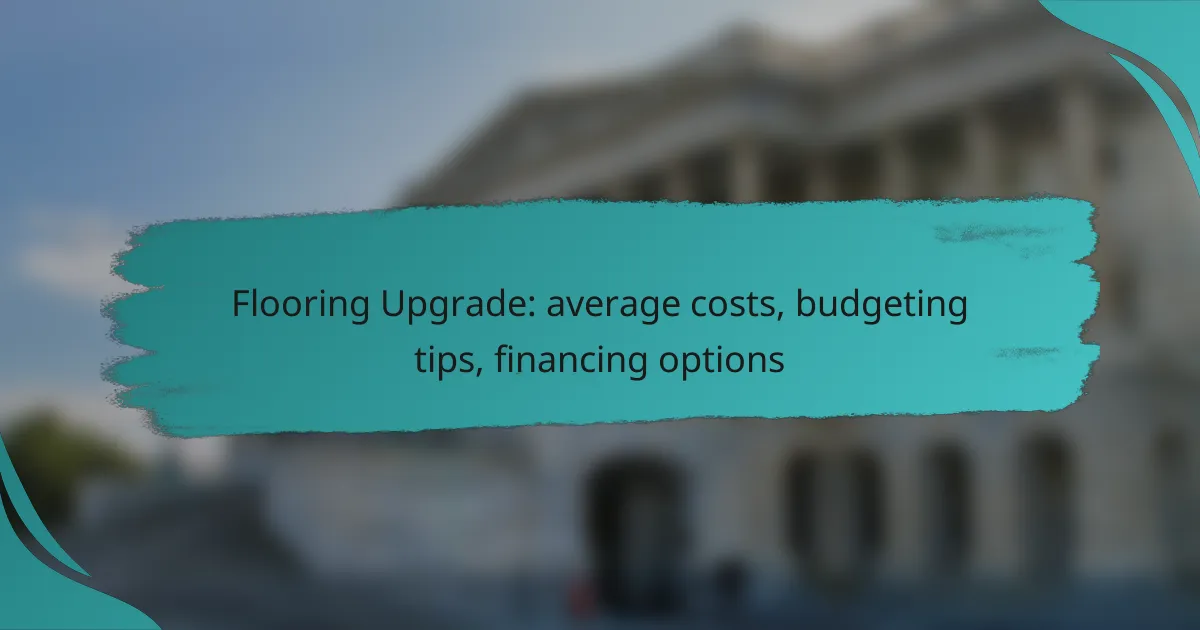Upgrading your flooring can significantly enhance the aesthetic and value of your home, but it’s important to understand the average costs involved, which can range widely based on material and installation. Careful budgeting is essential to cover not only the expected expenses but also any unforeseen costs that may arise during the project. Additionally, exploring various financing options can provide flexibility in managing your flooring upgrade expenses.

What are the average flooring upgrade costs in Canada?
The average costs for flooring upgrades in Canada vary significantly based on the material chosen, installation complexity, and regional pricing. Generally, homeowners can expect to spend anywhere from a few dollars to over a hundred dollars per square foot, depending on the flooring type and quality.
Cost range for hardwood flooring
Hardwood flooring typically ranges from CAD 8 to CAD 15 per square foot, including installation. The price can vary based on the wood species, finish, and whether it is solid or engineered hardwood.
Higher-end options, such as exotic woods, can exceed CAD 20 per square foot. Consider the long-term value and durability of hardwood, as it often increases home resale value.
Cost range for laminate flooring
Laminate flooring is a more budget-friendly option, with costs ranging from CAD 2 to CAD 8 per square foot installed. This material mimics the appearance of wood or stone while being more resistant to scratches and moisture.
While laminate is less expensive upfront, it may not provide the same longevity as hardwood. Evaluate your lifestyle and the expected wear and tear when choosing laminate.
Cost range for tile flooring
Tile flooring costs can vary widely, typically ranging from CAD 5 to CAD 15 per square foot, including installation. Ceramic tiles are generally on the lower end, while porcelain and natural stone tiles can be more expensive.
Consider the tile’s durability and maintenance requirements, as some types may require sealing or special cleaning products, impacting long-term costs.
Cost range for carpet flooring
Carpet flooring usually costs between CAD 3 and CAD 10 per square foot, including installation. The price can depend on the carpet material, pile height, and brand.
While carpet can provide comfort and warmth, it may require more frequent cleaning and replacement compared to harder surfaces. Assess the area’s traffic and potential for stains when selecting carpet.
Factors affecting flooring costs
Additionally, consider the costs of underlayment, removal of existing flooring, and any necessary repairs to the subfloor. Budgeting for these extras can help avoid surprises during your flooring upgrade project.

How to budget for a flooring upgrade?
Budgeting for a flooring upgrade involves assessing your needs, determining costs, and planning for unexpected expenses. A well-structured budget helps ensure you can afford the materials and labor while avoiding financial strain.
Creating a flooring budget plan
Start by researching the types of flooring you want, such as hardwood, laminate, or tile, and their associated costs. Prices can vary significantly, typically ranging from $2 to $10 per square foot, depending on the material and quality. Include installation costs, which may add another $1 to $5 per square foot.
Next, measure the area you plan to upgrade to calculate the total square footage. Multiply the square footage by the cost per square foot to estimate the total material cost. Don’t forget to factor in additional expenses like underlayment, trim, and disposal fees.
Common budgeting mistakes
A frequent mistake is underestimating the total costs by not including all necessary components, such as installation and preparation work. Ensure you account for any subfloor repairs or leveling that may be needed before installation.
Another common error is neglecting to compare prices from multiple suppliers. Prices can vary widely, so shopping around can save you a significant amount. Additionally, avoid making impulsive decisions based on sales or promotions without considering your overall budget.
Setting aside a contingency fund
It’s wise to set aside a contingency fund of around 10-20% of your total budget for unexpected expenses. This fund can cover surprises like hidden damage or changes in material prices. Having this buffer can prevent financial stress during the project.
To create your contingency fund, calculate your estimated total costs and set aside the appropriate percentage. This proactive approach ensures you’re prepared for any unforeseen issues, allowing your flooring upgrade to proceed smoothly without financial strain.

What financing options are available for flooring upgrades?
Several financing options can help you manage the costs of flooring upgrades, including home improvement loans, credit card financing, and retail financing programs. Each option has its own terms and conditions, so it’s essential to evaluate which suits your financial situation best.
Home improvement loans
Home improvement loans are personal loans specifically designed for renovations, including flooring upgrades. These loans typically have fixed interest rates and terms ranging from three to ten years, making monthly payments predictable.
When considering a home improvement loan, check your credit score and shop around for the best rates. Many lenders offer loans up to $50,000, but the amount you qualify for will depend on your creditworthiness and income.
Credit card financing options
Using a credit card for flooring upgrades can be a convenient option, especially if you have a card with a low interest rate or a promotional 0% APR offer. This can allow you to spread payments over time without incurring interest if paid off within the promotional period.
However, be cautious of high-interest rates that can apply after the promotional period ends. It’s advisable to pay off the balance before the interest kicks in to avoid costly debt.
Retail financing programs
Many flooring retailers offer financing programs that can include deferred interest or low monthly payments. These programs often require a minimum purchase amount and may offer special promotions during sales events.
Before committing, read the fine print carefully to understand the terms, especially regarding interest rates and payment deadlines. Retail financing can be beneficial if you plan to make a larger purchase, but ensure you can meet the payment requirements to avoid penalties.

What are the best flooring materials for Canadian climates?
The best flooring materials for Canadian climates are those that can withstand temperature fluctuations and moisture. Vinyl, engineered hardwood, and laminate are popular choices due to their durability and resistance to humidity.
Benefits of vinyl flooring
Vinyl flooring is highly versatile and water-resistant, making it ideal for areas prone to moisture, such as basements and kitchens. It can mimic the look of natural materials like wood or stone while being more affordable and easier to maintain.
Additionally, vinyl is softer underfoot compared to harder surfaces, providing comfort and reducing noise. It is also available in a wide range of styles and colors, allowing for customization to fit various design preferences.
Advantages of engineered hardwood
Engineered hardwood offers the aesthetic appeal of solid wood with enhanced stability, making it suitable for fluctuating temperatures in Canadian homes. Its layered construction helps it resist warping and moisture, which is crucial in regions with high humidity or temperature changes.
This type of flooring can be refinished several times, extending its lifespan and maintaining its beauty. While it may come at a higher initial cost compared to vinyl, the long-term durability and elegance often justify the investment.

How to choose a flooring contractor in Canada?
Choosing a flooring contractor in Canada involves assessing their qualifications, experience, and customer feedback. It’s essential to select a contractor who meets local regulations and has a solid reputation for quality work.
Evaluating contractor credentials
Start by verifying the contractor’s licensing and insurance. In Canada, contractors should have a valid business license and liability insurance to protect you from potential damages or accidents during the project. Check if they are bonded, which provides an additional layer of security.
Review their experience in flooring installation, particularly with the type of flooring you want. Look for contractors who have been in business for several years and have a portfolio showcasing their previous work. Online reviews and testimonials can provide insights into their reliability and craftsmanship.
Questions to ask potential contractors
When interviewing contractors, ask about their experience with your specific flooring material and installation methods. Inquire about their process for preparing the subfloor and how they handle unexpected issues that may arise during installation.
It’s also important to discuss timelines and payment structures. Ask for a detailed estimate that includes labor, materials, and any additional costs. Ensure you understand their payment schedule and what is required upfront. Finally, request references from past clients to gauge their satisfaction with the contractor’s work.

What are the latest trends in flooring design?
Current flooring design trends focus on sustainability, versatility, and aesthetics. Popular choices include eco-friendly materials, textured finishes, and bold colors that enhance interior spaces.
Average costs of flooring upgrades
The average costs for flooring upgrades can vary widely based on material, installation, and location. Generally, homeowners can expect to spend anywhere from $3 to $15 per square foot for materials alone, with additional installation costs ranging from $1 to $5 per square foot.
For example, laminate flooring is often on the lower end of the spectrum, while hardwood and luxury vinyl can be more expensive. It’s essential to factor in both the cost of materials and labor when budgeting for a flooring project.
Budgeting tips for flooring projects
When budgeting for flooring upgrades, start by determining your total budget and then allocate funds for materials, installation, and any additional expenses such as underlayment or removal of old flooring. Prioritize your needs and consider cost-effective options that still meet your design goals.
It’s also wise to set aside a contingency fund of around 10-15% for unexpected costs that may arise during installation. Researching local suppliers and comparing prices can help you find the best deals.
Financing options for flooring upgrades
Financing options for flooring upgrades include personal loans, credit cards, and retailer financing plans. Many flooring retailers offer promotional financing, which can be beneficial if you need to spread out payments over time.
Before choosing a financing option, evaluate interest rates, terms, and any fees associated with the plan. It’s crucial to ensure that the monthly payments fit within your budget to avoid financial strain.
